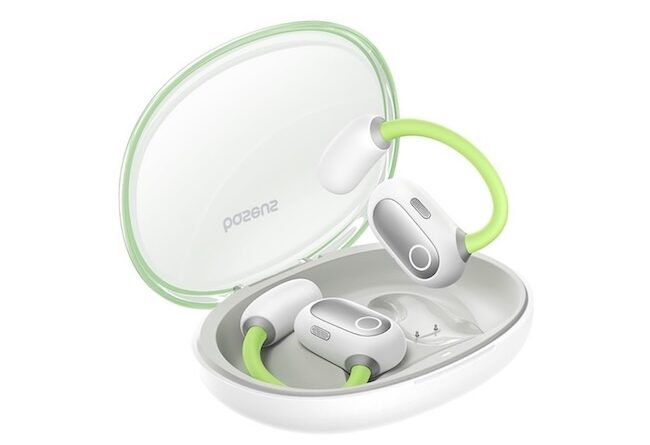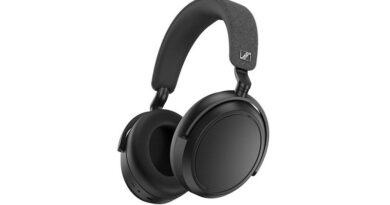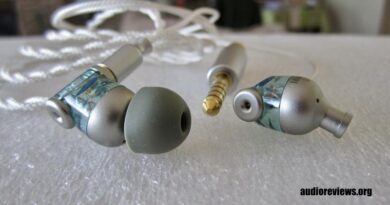Baseus Eli Sport 1 Open-Ear TWS Earbuds Review (1) – Real Men Don’t Wear Eyeshadow
In this Article
Once an embryonic novelty, open-ear buds are suddenly The Next Big thing, with mainstream players like Bose and Beyerdynamic hawking $200-$300 models and, predictably, a bevy of obscure Chifi makers cranking out imitations at much lower prices. All I’ve heard struggle to reproduce the full frequency and bass impact of traditional in-ears, though the Oladance Wearable come close. They also don’t play as loud or block out exterior noise well enough to be optimal for phone calls.
The current subject, the Baseus (SRP $75, though usually available <$50 on Amazon) promise to transcend these limitations and, for the most part, are true to their word, with a fuller-bodied sound than you’d expect. Broken down to its components:
Build/Design
Because they use bigger-than-standard (16mm) drivers, the Sport 1 are bulkier than their competitors, and the mostly plastic casings looks and feels less premium than the bespoke Oladance. However, they are surprisingly lightweight and comfortable for extended listening, while the rubbery, flexible earhooks provide for good adjustability and are more secure than they look. The removable lanyard is a nice touch which everyone should incorporate. Charging case is capacious but thin enough to be pocketable; 7hr. battery life isn’t class-leading, but competitive with the class.
Haptics/App/Mic
The Sport 1 utilizes touch controls (adjustable in the app), which have a logical tap/touch scheme and work reliably once you get accustomed to the very small touchable surface. The app is pretty basic—it provides for little more than EQ, a bloated, sludgy-sounding bass booster (which disables the EQ settings) and an inaudible low latency mode. The preset EQs aren’t very good—they tend to either understate high end or understate low end—but the custom EQ is very useful and, depending upon your settings, can significantly improve bass impact and overall clarity.
Indoor call quality is just fine; my listeners state my voice sounded undistorted and natural. Outdoors is more of a crapshoot—lots of wind noise intrudes and whatever ANC they use doesn’t work.
Sound
OOTB, in default mode, the Sport 1 didn’t sound much better than bone-conduction models, albeit with more impactful low end. They also didn’t get very loud. Dialing the custom EQ to my preferred signature (Harmon-ish, with enhanced midbass and some accent on the highest frequencies) made a huge, night-and-day improvement—bass tightened, mids moved front-stage and high-end gained a lot of sparkle and crispness.
As so tuned, notes have considerable body and richness for an open-ear, and presentation is “airy” in the sense of being uncongested, with good space between the instruments. Soundstage is wide, without the bunching you’d expect. Especially on acoustic and less dense material, these sound like open-back headphones.
The Sport 1 are slightly bright and forward—subbass isn’t deep by IEM standards, but surprisingly visceral and thumpy, while percussion has a nice snap. There’s an unexpected physicality to the Sport 1. Timbre is pretty good—smooth and undistorted, though it’s slightly compressed and lacks the realism and accuracy of good conventional TWS like the Cambridge Melomania; there’s some rounding-off and blurring of micro-detail at the higher end, although correspondingly there’s no harshness or excessive brightness.
Comparos
I A/B’d the Sport 1 with the very likeable Samsung Galaxy Live (which also have a tip-less design but fit right on top of the ear canal). The Samsung are warmer, less forward and have a more balanced signature and less low-bass emphasis. Soundstage is similarly wide, though the Sport 1 create the sense of more space between performers. Most notably, however, despite the lack of seal the Sport 1 are more immersive and punchier; they also present more high end detail. The Samsung sound flatter and less rangy in contrast.
The twice-the-price Oladance OWS is a beefier, slightly better-sounding phone, with a more forward, aggressive midrange and better overall dynamics. The Oladance also has more and better-sculpted midbass and sounds closer to an in-ear. Its qualitative improvement over the Baseus, however, is less than you’d think, with the latter actually imaging more precisely and doing a better job of reproducing drums and percussion. The Baseus also avoid the slight treble harshness than can affect the Oladance at high volumes.
Outro
I don’t want to oversell the Eli Sport 1—as good as they are, their design presents inherent limitations in terms of bass reproduction, and they won’t displace good wired IEMs for critical listening, and. However, these blow away any bone conduction model you’ll find and can legitimately tout its musical virtues as much as its technical features. That they can do so for fifty bucks is quite remarkable, and I recommend these without reservation.
Non-Disclaimer
Another random (drunk) purchase; no affiliation with no one.
Specifications Baseus Eli Sport 1
| Material: ABS+PC+metal+silicone Bluetooth Version: V5.3 Communication Distance: 10m Playback Time: About 7.5 hours (with volume at50%) Playback Time with the Charging Case: About30 hours (with volume at 50%) Battery Capacity: 65mAh/0.247Wh (earbuds),600mAh/2.22Wh (charging casse) Charging Case Rated Input: 5vm 1000mAEarbuds rated consumption current: 8.8mA Charging Case Rated Consumption Current: 380mA Charge Time: About 1 hourFrequency response range: 20Hz-20kHz Charge Port: USB-C Compatibility: with most Bluetooth playback devicesI Weight: 84g/ 3 ounces Package includes: Baseus Eli Sport1 Open Ear Headphones, Charging Case, Detachable Neckband, USB-C Charging Cable, User Manual Tested at: $75 Product Link: Baseus.com |







